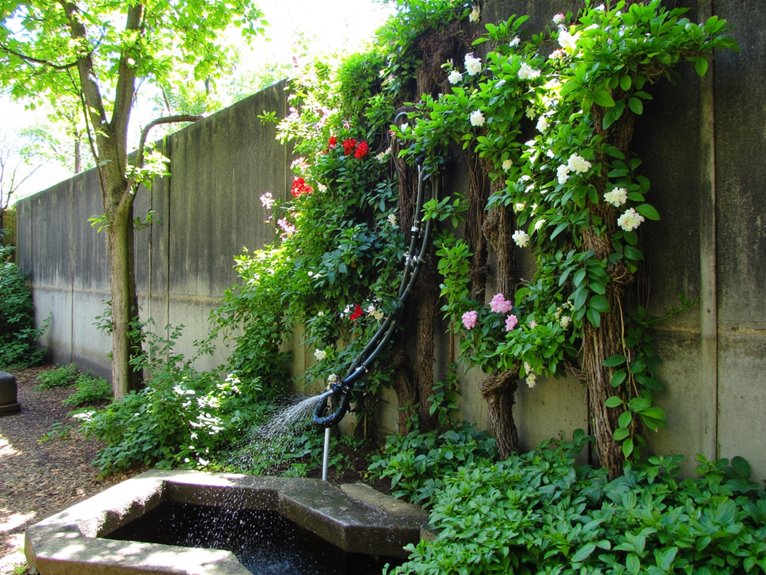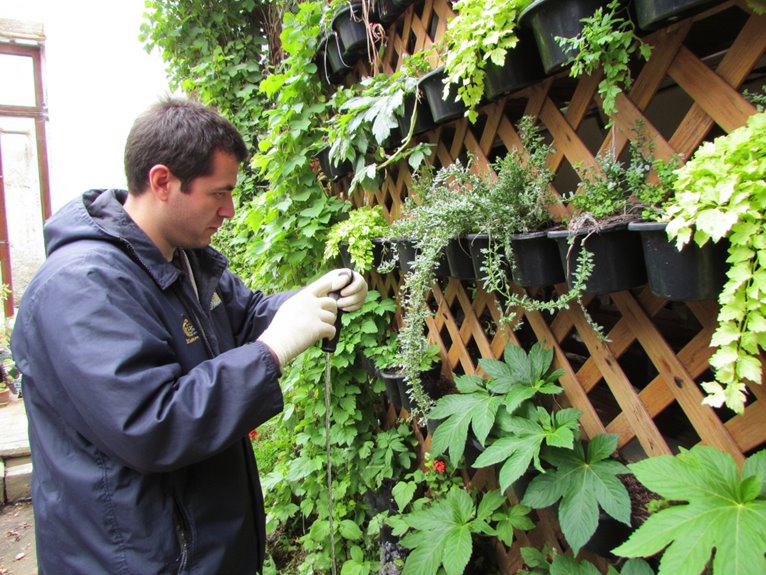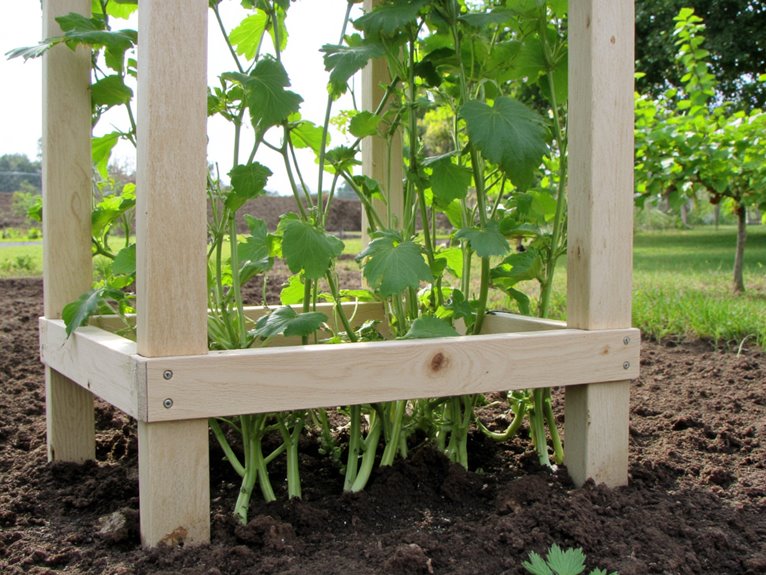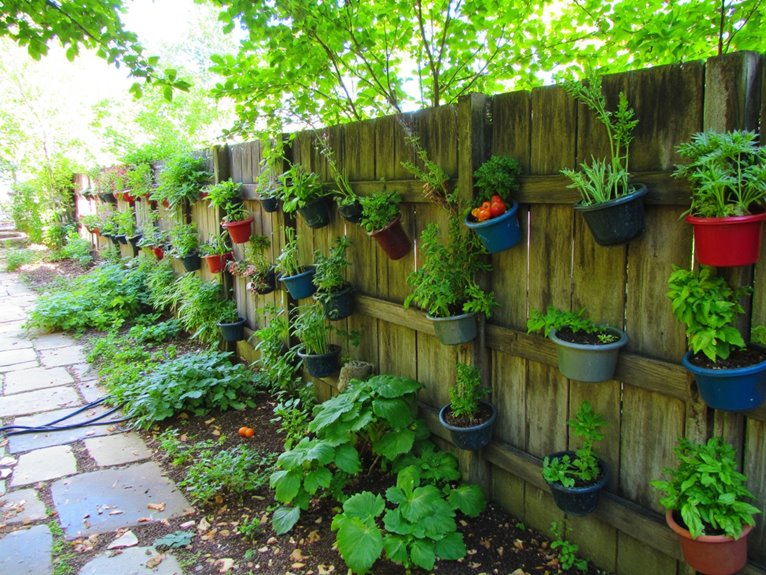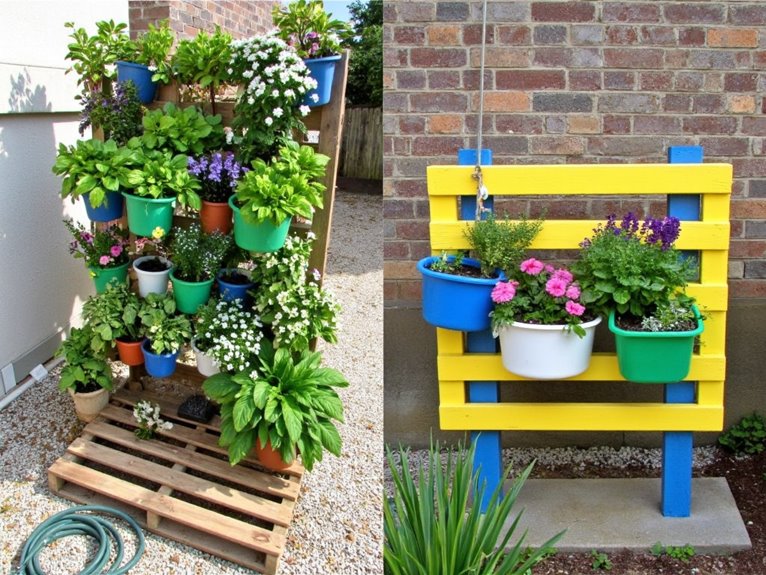Climbing Vegetable Garden Setup: Growing Beans, Peas, and Squash Vertically
Setup a climbing vegetable garden by choosing sturdy supports like trellises, obelisks, or cattle panels that match your plants’ needs—beans and peas love A-frames, while squash benefits from higher structures. Plant seeds in warm soil after the last frost, spacing them along the vertical frames for best growth. Regular maintenance, proper watering, and pruning will keep your garden thriving and productive all season long.
Notable Insights
- Use obelisks, A-frames, or panel trellises to support climbing beans, peas, and squash vertically.
- Plant beans/peas 1-1.5 inches deep in warm soil (60-70°F) and space seeds 2-3 per foot along supports.
- Install at least six-foot tall structures before planting to accommodate vine growth and prevent root damage.
- Prune lower leaves for airflow, remove male squash flowers to focus energy on fruit development, and pinch back vines to encourage branching.
- Use drip irrigation, regular fertilizing based on each vegetable’s needs, and organic pesticides to maintain healthy vertical growth.
Selecting Effective Vertical Support Systems
As you set up your vertical garden, choosing the right support system isn’t just about holding plants up—it’s about creating a framework that enhances growth, reduces disease risk, and maximizes space. Explore trellis design types like obelisks for central stability or A-frames for wide-spreading vines, while considering support material options such as rust-resistant metal or treated wood. Panel trellises offer easy installation for beans and peas, while cattle panels provide robust overhead structures for greenhouses. Prioritize textured surfaces for better vine grip and guarantee airflow to prevent rot. Whether you’re growing delicate peas or heavy squash, the right combination of design and material will transform your garden into a thriving vertical ecosystem.
This approach particularly benefits melons and tomatillos, which stay cleaner and more pest-free when suspended off the ground (VERTICAL POSITIONING). For gardeners seeking low-maintenance alternatives in challenging growing conditions, UV-resistant materials can provide consistent greenery while you establish your living vertical systems.
Choosing Climbing Vegetable Varieties
After setting up your vertical framework, selecting the right climbing vegetables will maximize your garden’s potential. Pole beans like Blauhilde offer colorful pods perfect for trellises, while runner beans add beauty with red flowers. Sugar snap peas and snow peas thrive vertically, providing crisp, sweet harvests. When choosing, prioritize genetic resistance to diseases common in your area. Varieties with strong tendrils or clinging structures will support themselves better. Consider flavor profiles—purple pole beans deliver unique taste, while butternut squash offers nutty depth. Opt for plants that match your climate and garden space. Ensure your support structures can accommodate the weight capacity of mature vines loaded with pods and fruit for optimal performance. With the right choices, your vertical plot can burst with fresh produce all season long.
Vertical gardening efficiency is particularly notable with climbing vegetables, as they utilize overhead space and often produce 2-3 times more yield than ground-level plantings.
Preparing Your Garden Site for Vertical Planting
Garden Preparation for Vertical Climbers
Before you even think about planting, getting your garden site ready is key to ensuring those vertical climbers really take off, though it might feel like work at first – imagine clearing away weeds that could otherwise steal nutrients from your precious crops. Start by cutting existing vegetation short and removing persistent perennials like dandelions. For stubborn weeds and grass, consider using fast-acting solutions that provide visible results within hours to ensure a clean planting area. Loosen compacted soil with a fork to improve drainage solutions essential for preventing waterlogged roots. Test your soil’s pH level and amend it with lime or sulfur as needed to create the ideal 6.0-7.0 range for vegetable growth. For raised beds, add composted organic matter to enrich fertility while ensuring proper drainage. Finally, plan sturdy supports at least six feet tall to accommodate climbing vines – wooden posts tied with wire or netted trellises work best.
Select durable frames like timber lattice or wire mesh to provide stable support for climbing vegetables.
Proper Planting Techniques for Vertical Gardens
Once your vertical garden site is prepped, planting becomes a matter of matching the right varieties to your structures and giving each vine its space to climb – whether you’re growing beans, peas, or squash. For best seed germination conditions, plant beans and peas 1-1.5 inches deep in warm soil (60-70°F), while squash seeds require slightly deeper planting due to their size. Use containers with ample container drainage solutions to prevent waterlogging, especially for elevated beds or hanging baskets. Space bean and pea seeds 2-3 per foot along trellises to encourage competition for strength, but leave 12-18 inches between squash plants to accommodate their broader vine growth. Always plant after the last frost, when temperatures consistently stay above 55°F for rapid vine development.
Maintaining Your Vertical Vegetable Setup
With the framework in place and seeds nestled into their new homes, it’s time to shift focus upward to the care routines that keep your vertical garden thriving throughout the season. Regularly inspect Repairing Trellis Structures for signs of wear—beans and peas can be particularly heavy once fruit forms—and reinforce as needed. As seasons change, don’t forget to Clean Grow Media Annually, replacing or topping up soil to replenish nutrients lost through growth.
Managing Pests in a Vertical Garden
| Pest Type | Control Method | Placement |
|---|---|---|
| Aphids | Ladybugs | Plant tops |
| Spider Mites | Neem Oil | Under leaves |
| Whiteflies | Yellow Sticky Traps | Above canopy |
| Thrips | Garlic Spray | Mid-plant |
| Caterpillars | Parasitic Wasps | Near host plants |
Keep row covers secure and prune regularly to improve airflow. Monitor closely and act early to keep your vertical garden thriving.
Watering Strategies for Climbing Vegetables
As you set up your vertical garden, remember that proper watering is just as important as the right support system. Vertical setups dry out faster, so focus on Water retention methods like quality potting soil and organic mulches. Beans and peas need consistent moisture—water every 2–3 days during active growth. For squash, which uses more water due to large leaves, check soil frequently and adjust based on drying times. Use drip irrigation or self-watering containers for efficient Drought resistance techniques. Always monitor moisture levels closely, as upper planters can dry out quickly. With the right approach, your climbing vegetables will thrive vertically!
Fertilizing Vertical Garden Plants
While traditional gardens benefit from rich soil, vertical gardens require careful attention to nutrient delivery due to their limited volume. For climbing vegetables like beans, peas, and squash, start with an 80/20 topsoil-compost mix for balanced nutrients. Organic methods—like vermicomposting or slow-release fertilizers—are ideal for sustained feeding without burning plants. Compare organic vs synthetic effectiveness: organics release nutrients gradually while synthetics act quickly but may leach faster. Use balanced N-P-K ratios initially, then switch to low-nitrogen feeds as fruits develop. Deliver nutrients through planting media, compost cores, or drip systems that match vertical garden structures. Regular feeding maintains productivity in high-density setups.
Pruning Tips for Healthy Growth
Although pruning might seem simple, it plays a vital role in keeping your vertical garden thriving—think of it as giving plants a haircut that promotes growth rather than hinders it. When trimming climbing vegetables like beans and peas, focus on cutting angles that encourage branching and fruit production. Always use sharp tools and practice tool sterilization to prevent disease spread between plants.
For squash, remove excess male flowers and weak fruits to direct energy where it’s needed most. Keep the base of plants clear by trimming lower leaves to improve airflow and reduce pests. Regular inspections let you catch issues early while shaping your garden for ideal growth.
Harvesting From Your Vertical Garden
When you’ve got your climbing vegetables coiled around trellises or cascading from hanging baskets, picking them becomes not just easier but almost intuitive—you can spot ripe pods and squash blossoms at a glance. Harvest timing is key; beans and peas should be picked daily as they mature quickly, while squash waits until the skin hardens.
Produce storage matters too—keep herbs dry, wrap tomatoes in paper towels, and hang peppers in cool dark places. Vertical gardens cut washing time dramatically since fruits rarely touch soil. Just twist or cut carefully to avoid damaging vines, and you’ll enjoy fresh harvests all season long.
Frequently Asked Questions
How Do I Prevent Vertical Plants From Breaking in Wind?
To prevent vertical plants from breaking in wind, use wind resistant plant training techniques like tying vines close to supports and choosing flexible species. Combine with natural stabilizers like deep-rooted companion plants and physical barriers to create a resilient garden setup.
Can I Grow Vertical Vegetables in Containers on a Balcony?
You sure can – just check balcony container weight limits first! Use lightweight pots and add vertical irrigation techniques like self-watering systems or drip lines. Hang baskets, trellises, and stackable planters maximize space while keeping roots happy and water needs minimal.
What’s the Best Way to Support Heavy Squash Vines Vertically?
You’ll want to use cattle panels or wire mesh for squash vines, which can get pretty heavy. Combine this with pumpkin pruning to keep plants focused and cucumber spacing to avoid overcrowding. Add mesh bags or cloth slings for large fruits, and secure everything well – don’t let those vines dangle unsupported!
How Do I Choose Between Trellises and Cages for My Garden?
I should choose trellises for beans and peas that climb straight up, while cages work better for bushier plants like tomatoes. Trellises offer cost-effective wood or metal options that improve airflow, but cages made from durable wire or mesh support heavier squash vines without toppling.
Are There Any Vegetables That Shouldn’t Be Grown Vertically?
Yeah, there are veggies you shouldn’t grow vertically—root vegetables, tubers, and plants with taproots should generally be avoided for vertical growth as their natural growth pattern is horizontal underground. Bulb crops like onions and garlic also store energy in underground structures rather than developing climbing habits.
On a final note
With your vertical garden thriving and harvests abundant, you’ve mastered the art of growing beans, peas, and squash upward rather than outward—maximizing space while enjoying nature’s bounty from eye level. Let this success inspire further exploration into efficient gardening techniques that celebrate both practicality and connection to the earth.
You’re well on your way to becoming a confident gardener capable of transforming any area into a productive green oasis. Keep learning, experimenting, and watching as your skills grow just like those climbing vines!

